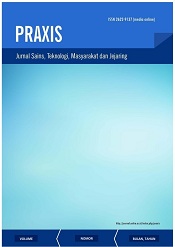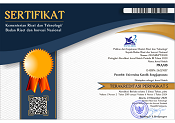Adaptasi Alat Ukur Kepuasan Kerja Untuk Tenaga K esehatan di Indonesia
Abstract
Job satisfaction has been an important topic of focus in the organizational setting for the last few decades. This research aims to validate job satisfaction scale in medical practitioner population. The 10 items in this scale consist of 4 extrinsic facet items and 5 intrinsic facet items. This intrument was adapted into Bahasa Indonesia as suggested by Beaton, et al. (2000) and analyzed using confirmatory factor analysis. The study conducted among 287 participants working in the medical field. The study showed that the reliability of intrinsic facet is .811 and extrinsic facet .729. Further analysis found that there is correlation between intrinsic and extrinsic job satisfaction. This study concluded that the job satisfaction scale used in this study is valid and reliable to be applied in medical practitioner in Indonesia.
Abstrak
Alat ukur kepuasan kerja telah digunakan di berbagai bidang pekerjaan termasuk kesehatan. Sayangnya di Indonesia penelitian mengenai alat ukur ini sendiri masih sangat terbatas, terutama mengenai konstruk kepuasan kerja dengan subjek khusus tenaga kesehatan. Penelitian ini bertujuan untuk mengadaptasi skala kepuasan kerja untuk tenaga kesehatan dari Hills, Joyce dan Humphreys (2012) ke dalam bahasa Indonesia. Proses penerjemahan berdasarkan langkah-langkah yang disarankan oleh Beaton, dkk. (2000). Alat ukur kepuasan kerja yang digunakan terbagi menjadi dua berdasarkan sumbernya, yaitu ekstrinsik dan intrinsik, dengan total 10 aitem. Peserta yang terlibat dalam penelitian ini sebanyak 287 responden. Berdasarkan hasil uji reliabilitas didapatkan koefisien alfa sebesar .811 untuk kepuasan kerja yang bersifat intrinsik dan .729 untuk kepuasan kerja yang bersifat ekstrinsik. Berdasarkan hasil uji validitas dengan teknik faktor analisis dan uji reliabilitas, dapat disimpulkan bahwa alat ukur ini cukup valid dan reliabel untuk diterapkan di Indonesia. Berdasarkan analisis tambahan yang dilakukan, ditemukan hubungan antara sumber kepuasan kerja yang bersifat intrinsik dan ekstrinsik
Keywords
Full Text:
PDFReferences
Aamodt,M.(2012). Industrial/ organizational psychology: An applied approach. Nelson Education.
Andini, R. (2010). Analisis pengaruh kepuasan gaji, kepuasan kerja, komitmen organisasional terhadap turnover intention. Dinamika Sains, 8(16).
Beaton, D. E., Bombardier, C., Guillemin, F., & Ferraz, M. B. (2000). Guidelines for the process of cross-cultural adaptation of self-report measures. Spine, 25(24), 3186-3191.
Bellou, V. (2010). Organizational culture as a predictor of job satisfaction: the role of gender and age. Career Development International, 15(1), 4-19.
Byrne, B.M. (2001). Structural equation modeling with Amos: Basic concepts, application and programming. Mahwah, NJ.: Erlbaum.
Cydulka, R. K., & Korte, R. (2008). Career satisfaction in emergency medicine: the ABEM Longitudinal Study of Emergency Physicians. Annals of emergency medicine, 51(6), 714-722.
Cooper, C. L., Rout, U., & Faragher, B. (1989). Mental health, job satisfaction, and job stress among general practitioners. British Medical Journal, 298, 366-370.
Dahlan A. Malek, M., Mearns, K., & Flin, R. (2010). Stress and psychological well-being in UK and Malaysian fire fighters. Cross Cultural Management: An International Journal, 17(1), 50-61.
Dormann, C., & Zapf, D. (2001). Job satisfaction: A meta-analysis of stabilities. Journal of Organizational Behavior, 22, 483–504.
Faragher, E. B., Cass, M., & Cooper, C. L. (2005). The relationship between job satisfaction and health: a meta-analysis. Occupational and environmental medicine, 62(2), 105-112.
Fisher, C. D. (2003). Why do lay people believe that satisfaction and performance are correlated? Possible sources of commonsense theory. Journal of Organizational Behavior, 24(6), 753–777.
Hair, J. F., Black, W. C., Babin, B. J., Anderson, R. E., & Tatham, R. L. (2006). Multivariate data analysis 6th Edition. Pearson Prentice Hall. New Jersey. humans: Critique and reformulation. Journal of Abnormal Psychology, 87, 49-74.
Heritage, B., Pollock, C., & Roberts, L. D. (2015). Confirmatory Factor Analysis of Warr, Cook, and Wall's (1979) Job Satisfaction Scale. Australian Psychologist, 50(2), 122-129.
Herzberg, F., Mausner, B. & Snyderman, B. (1959). The Motivation to Work, Wiley. New York, NY.
Hills, D., Joyce, C., & Humphreys, J. (2012). Validation of a job satisfaction scale in the Australian clinical medical workforce. Evaluation & the health professions, 35(1), 47-76.
Hu, L. T., & Bentler, P. M. (1999). Cutoff criteria for fit indexes in covariance structure analysis: Conventional criteria versus new alternatives. Structural equation modeling: a multidisciplinary journal, 6(1), 1-55.
Janus, K., Amelung, V. E., Baker, L. C., Gaitanides, M., Schwartz, F. W., & Rundall, T. G. (2008). Job satisfaction and motivation among physicians in academic medical centers: insights from a cross-national study. Journal of Health Politics, Policy and Law, 33(6), 1133-1167.
Kaplan, R. M. & Saccuzzo. (2005). Psychological testing: Principles, application, and issues (6th ed.). Belmont: Thomson Wadsworth.
Kenny, D. A. (2012). Multiple latent variable models: Confirmatory factor analysis. Davidakenny. net. Retrieved January, 2, 2015.
Locke, E.A. (1976). The nature and causes of job satisfaction. In M.D. Dunnette (Ed.), Handbook of industrial and organizational psychology (pp.1297-1349). Chicago: Rand McNally.
Meyer, J. P., Allen, N. J., & Smith, C. A. (1993). Commitment to organizations and occupations: Extension and test of a three-component conceptualization. Journal of applied psychology, 78(4), 538.
Paul, C., & Cozby, S. C. B. (2012). Methods in Behavioral Research.
Safarah, S. H., Widjanarko, B., & Shaluhiyah, Z. (2018). Faktor–faktor yang berhubungan dengan kepuasan kerja dokter spesialis terhadap pelaksanaan bpjs kesehatan di rumah sakit panti wilasa dr. Cipto. Jurnal Kesehatan Masyarakat (e-Journal), 6(1), 809-818.
Seston, E., Hassell, K., Ferguson, J., & Hann, M. (2009). Exploring the relationship between pharmacists' job satisfaction, intention to quit the profession, and actual quitting. Research in Social and Administrative pharmacy, 5(2), 121-132.
Silaban, E. J., & Andri, S. (2018). Pengaruh motivasi kerja dan kepuasan kerja terhadap komitmen perawat (Kasus rumah sakit ibu dan anak eria bunda pekanbaru). Jurnal Online Mahasiswa Fakultas Ilmu Sosial dan Ilmu Politik Universitas Riau, 5(1), 1-11.).
Smith, P.C., Kendall, L.M.,&Hulin, C.L. (1969). The measurement of satisfaction in work and retirement. Chicago: Rand McNally.
Spector, P.E. (1997). Job satisfaction: Application, assessment, causes, and consequences. Thousand Oaks: Sage
Theron, A. (2006). Attitudes and values. In Z. Bergh & A. Theron (Eds.), Psychology in the work context (pp. 173–187). CapeTown, South Africa: Oxford University Press
Warr, P., Cook, J., & Wall, T. (1979). Scales for the measurement of some work attitudes and aspects of psychological well‐being. Journal of occupational Psychology, 52(2), 129-148.
Warr, P., & Inceoglu, I. (2012). Job engagement, job satisfaction, and contrasting associations with person–job fit. Journal of occupational health psychology, 17(2), 129.
Weiss, D.J., Dawis, R.V., England, G.W., & Lofquist, L.H. (1967). Manual for the Minnesota Satisfaction Questionnaire. Minneapolis: University of Minnesota
DOI: https://doi.org/10.24167/praxis.v2i1.2303
View My Stats | ISSN 2622-9137 (media online)







